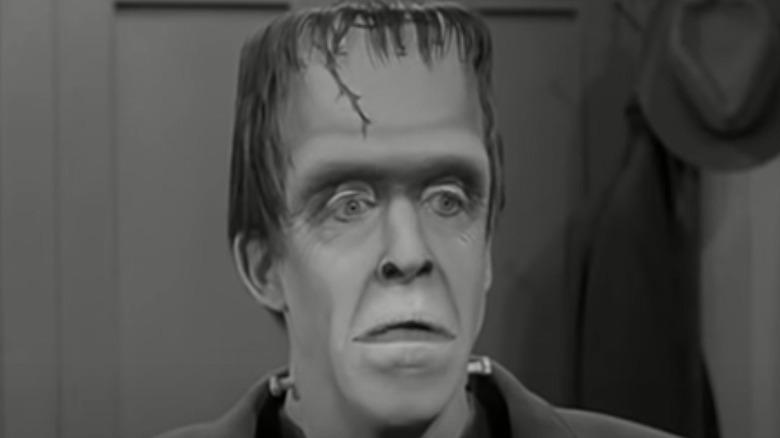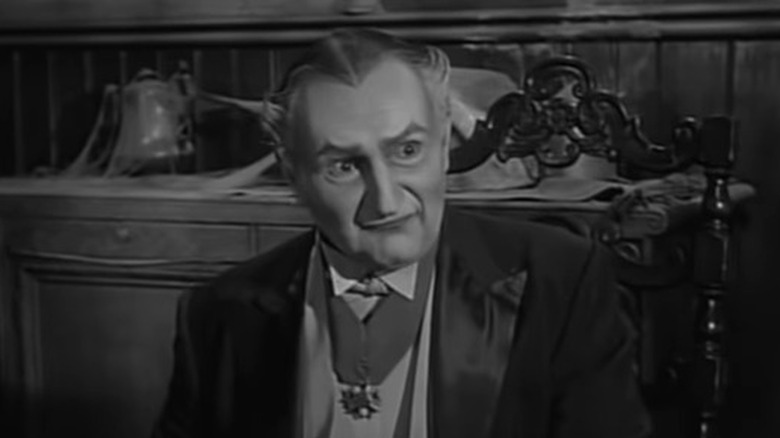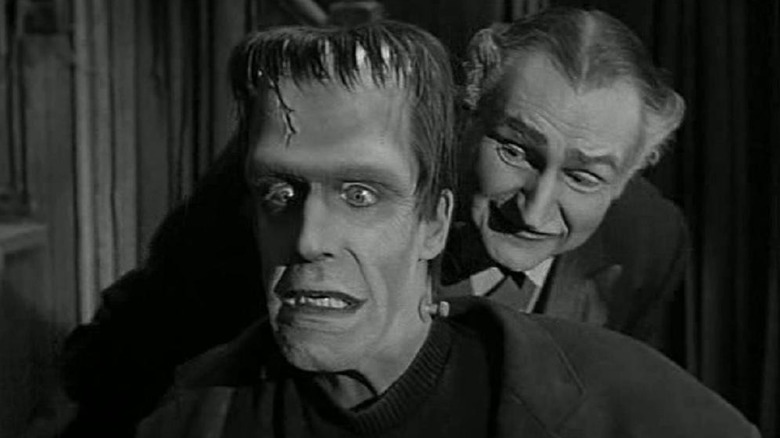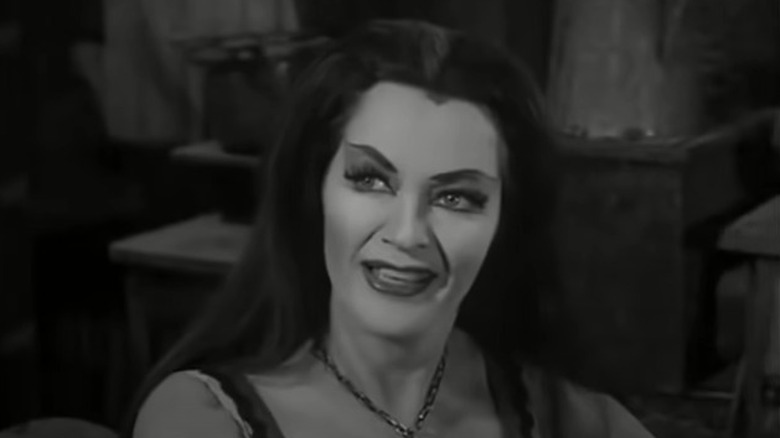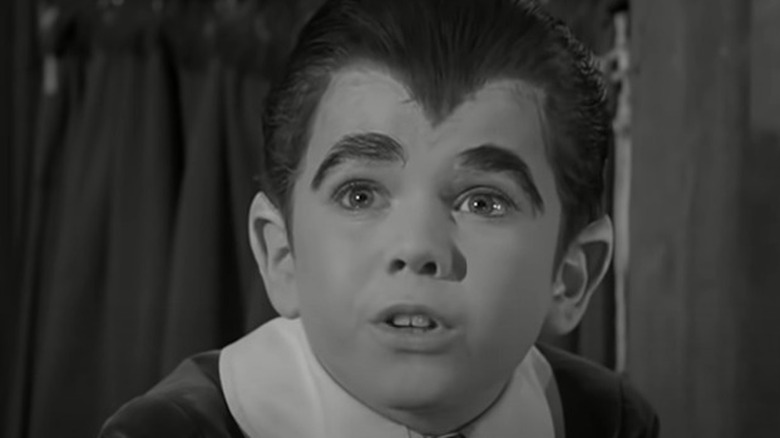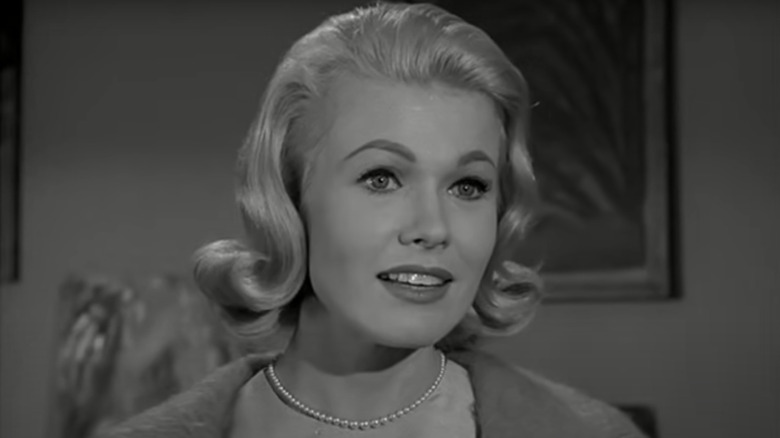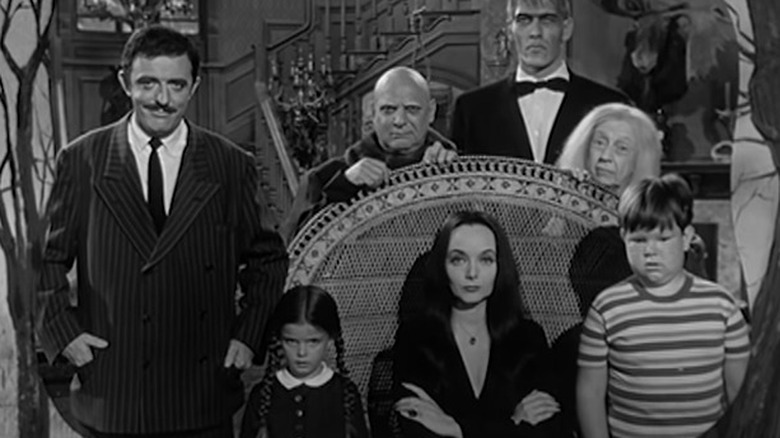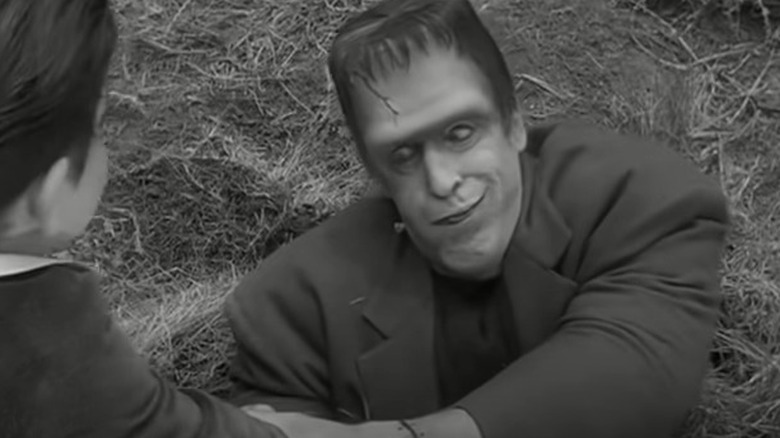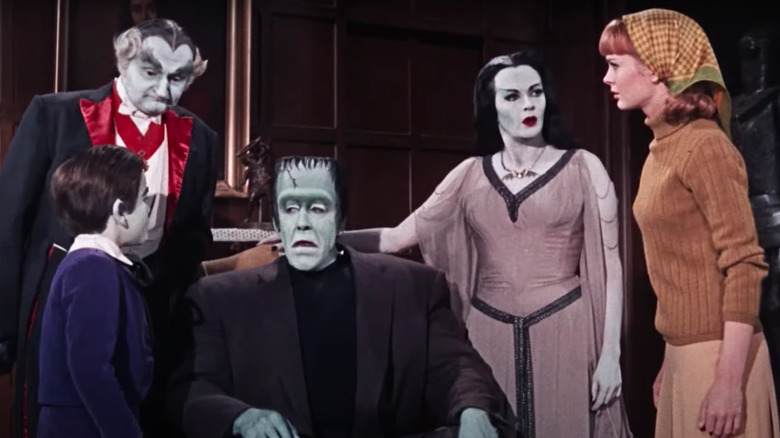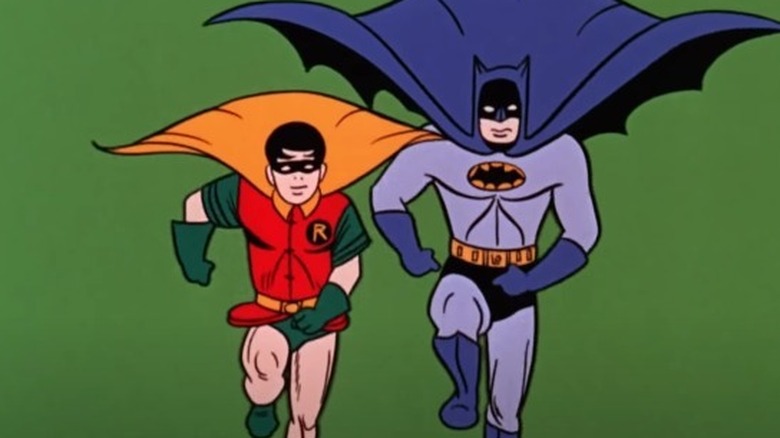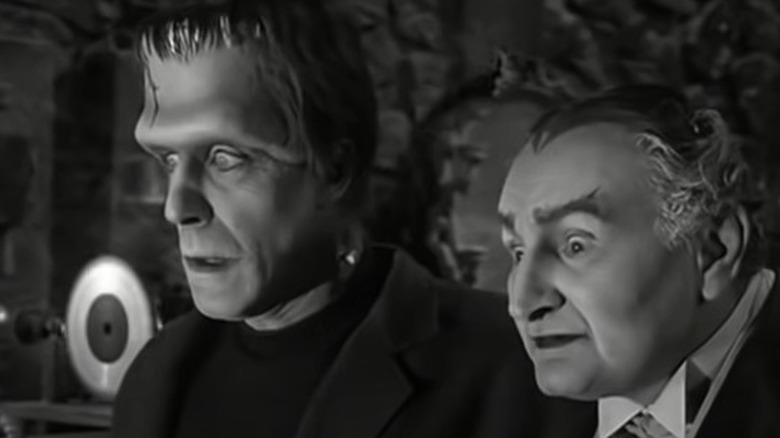The Real Reason The Munsters Got Canceled In 1966
Premiering on September 24, 1964, "The Munsters" was a black and white series that reimagined some of cinema's greatest monsters as members of a loving, suburban television family. The Munsters family consists of Herman Munster, who bears a striking resemblance to Frankenstein's monster; Lily, a vampire with a streak of gray hair like The Bride of Frankenstein; Grandpa, an old vampire obsessed with magic and science experiments; the werewolf boy Eddie; and the unfortunate Marilyn, who looks more like a model of the time rather than a monster.
A spoof of popular family sitcoms of the time, like "Leave it to Beaver" and "My Three Sons," "The Munsters" told wholesome, family-friendly stories with a macabre bent that was a hit with audiences at the time. With its iconic theme song and instantly recognizable cast of characters, it's hard to imagine that the show only ran for two years. However, that's exactly what happened. After producing just 72 episodes, "The Munsters" ended its primary television run on May 12, 1966 (per IMDb) — but it never left the cultural zeitgeist.
We're going to take a look at the history of the classic series, and try to deduce real reason "The Munsters" got canceled in 1966.
The Munsters creators were robbed
The assumption that "The Munsters" was a cash-grab on the success of "The Addams Family" is only partially correct. For starters, "The Addams Family" series was released only six days prior to the premiere of "The Munsters," which is nowhere near enough time to put another show together. However, the Charles Addams comic strip the show was based on did serve as an influence in the creation of "The Munsters."
"The Munsters" co-creator, Allan Burns, had been working on "The Bullwinkle Show" and wanted to get out of animation. He and writing partner Chris Hayward toyed with the idea of creating a show about a "weird, offbeat" family, "loosely based ... on the Charles Addams cartoons." While talking to the Archive of American Television, Burns explained they wanted to create their own take on that concept and developed "Meet The Munsters."
The two writers met with the head of comedy development at Universal several times to flesh out the world and characters, but never on the Universal lot. They wrote the script and stopped hearing from this executive. When they found out "The Munsters" was going into production without them, they discovered that the characters had been changed into what we recognize today.
According to Burns, the executive they worked with hired two other writers, Norm Leibmann and Ed Haas, to develop it further. Eventually, credit was worked out, and Burns and Hayward got paid, but "The Munsters" started life as a stolen idea.
Herman and Grandpa, where are you?
One of the many elements of "The Munsters" that makes it work so well is the character dynamics. Herman and Lily seemed to genuinely love each other. They clearly want the best for their son, Eddie, and their niece, Marilyn, and they both loved/tolerated Lily's father, Grandpa Munster. This is a real family who happen to also be monsters. Without that, the show doesn't work.
The actors who portrayed Herman and Grandpa were Fred Gwynne and Al Lewis. Aside from the two of them being very talented actors and comedy performers, they were able to forge a comedy bond by working together previously from 1961 to 1963 on the police sitcom "Car 54, Where Are You?" In that series, Gwynne plays Officer Francis Muldoon, a quiet, intelligent bachelor who lives with his mother and sisters. Lewis plays Officer Leo Schnauser, the kind of typical sitcom married man who doesn't seem to always get along with, or even understand, his wife, played by TV legend Charlotte Rae.
While these characters aren't exactly the templates for Herman and Grandpa, the fact that the two actors had so much experience working together meant their chemistry on screen was palpable, ensuring their characters would be remembered for decades.
The big, scary movie star
The original pilot for "The Munsters" looked very different to the show we eventually got. The most obvious differences are the fact that the pilot is in color and a few of the actors are different. In fact, Lily Munster wasn't even part of the unaired pilot. Originally, Herman's wife's name was Phoebe and she was played by Joan Marshall, whom some readers may remember as Lieutenant Areel Shaw in "Star Trek," or Wilma in an episode of "The Twilight Zone" called "Deadman's Shoes."
Phoebe's appearance and demeanor was remarkably similar to that of Carolyn Jones' portrayal of Morticia Addams, possibly leading to the decision to recast, according to the documentary "The Munsters: America's First Family of Fright." When the show went to series, in black and white, the character was renamed Lily, and actress Yvonne De Carlo was brought on to play her. Prior to this, De Carlo had been seen in the biblical epic "The Ten Commandments" along with many other films. In other words, "she was a big star in the movies," as Al Lewis described her to The Television Academy Foundation.
In fact, upon hearing that such a big name had been cast, Lewis and Fred Gwynne, under the spell of "reverse snobbery," complained to producers, presumably over the perception that someone like her would be willing to commit to this kind of comedy. Of course, De Carlo embodied Lily so well and played off of Gwynne and Lewis so naturally that, years later, Lewis admitted, "We were wrong."
An unhappy Eddie
The other casting change-up from the original pilot was that of actor Happy Derman. Prior to filming, the youngster had small roles on the shows "The Joey Bishop Show" and "The Beverly Hillbillies." His portrayal of Eddie Munster was very different from what audiences would come to know and love when the show actually went to series. He played Eddie as an almost feral character, snarling in the corner, growling as he spoke. Not only does it not suit the average kid image the show eventually adopted, it doesn't even fit the dynamic of the characters. Yes, the Munsters are monsters, but they're still just people.
His role would go to Butch Patrick, who gave Eddie the all-American boy charm of other shows like "Leave it to Beaver." In the television documentary "The Munsters: America's First Family of Fright," Patrick theorizes that the producers weren't happy with Derman's performance. He felt they wanted Eddie to be "a regular kid" and Happy was "the meanest little kid [he'd] ever seen." With the casting of Patrick, the show was one step closer to being the iconic classic that would go on to endure for many years to come.
The two Marilyns
Marilyn is the black sheep of the Munster family. To the outside world, and viewers at home, she looks like your classic blonde movie star. Given her hair and name, it wouldn't be much of a stretch to assume that the producers were hoping to evoke the image of Marilyn Monroe. A young woman like her shouldn't have any trouble finding someone to spend the rest of her life with, right? Well, finding a partner isn't the problem. Keeping one is a nightmare.
The joke with Marilyn is that she and her family think that she's unfortunate looking. While it's obvious to us that men are afraid of her monstrous family, she thinks she's the problem. As far as she and her family are concerned, Marilyn is cursed with bad looks. This works because the Munsters think they are the most normal people in the world and we start to think of them as normal as well. Therefore, when we get reminded that this isn't the case, it brings us back to reality and makes us laugh.
Beverly Owen played Marilyn in the original pilot and the first thirteen episodes of the show. She was, however, unhappy living in California and wanted to move back with her boyfriend in New York. Her replacement, Pat Priest (shown above), discussed this during a virtual Galaxycon panel, saying that she was on set and working within five days of her initial screen test, of which she beat out at least five other women for the part.
Munsters Vs. Addams
One could be forgiven for assuming that television audiences in the '60s were forced to choose between a love for "The Addams Family" or "The Munsters." The two shows, as discussed earlier, have similar origins. While "The Munsters" was inspired by Charles Addams' cartoons in The New Yorker, the series inevitably decided to lean into the iconography of the classic monster films produced by Universal. "The Addams Family" series was directly adapted from the cartoons themselves. The concepts of weird, macabre families interacting with a grounded world are very similar, of course, but the shows were different enough to share broadcast space.
Like the division between drinkers of Coca-Cola and Pepsi, or readers of Marvel and DC, it seems natural to assume that the audiences for "Addams" and "Munsters" were split down the middle. However, Eddie Munster himself, Butch Patrick, thinks the two shows fed into each other, rather than canceling each other out. During an interview with the Australian morning show "Studio 10," the actor pointed out that "The Munsters" was on Thursday night and "The Addams Family" was on Friday night and that likely helped both shows. In his opinion, fans of one would likely watch the other as well.
Wearing a bit thin
The first season of "The Munsters" consisted of 38 episodes. That is a ton of work for writers and performers, not to mention a lot to ask in terms of audience attention. It's particularly striking now, when compared to the six to 14 episodes we often get from streaming services — or even the 22-24 episodes of typical broadcast network fare. In addition to all these episodes, the cast did live appearances, public service announcements, and commercials, all in an effort to capitalize on the lightning-in-a-bottle success of the hit show, according to Michael Dann, CBS' head of programming at the time, who spoke about the intentional marketing blitz in "The Munsters: America's First Family of Fright" documentary.
In the second season, the stories became much broader. This approach may have been an additional attempt to keep as wide an audience as possible, but to the actors, it led to some unfulfilling work. In the same documentary, Al Lewis said that he and Gwynne felt the show wasn't living up to its potential. He felt it could have been "more satirical," as it had been during the first season where racism and bigotry of this strange family was openly mocked. Lewis wouldn't go so far as to say "that the scripts were bad," but felt "they could be better."
Although not explicitly stated, one could infer that a kind of oversaturation and declining stories might have led to the show's cancellation following this second season.
A new world of color
When "The Munsters" premiered in 1964, black and white televisions were still the standard in American households. The first color television system was developed during the later half of the 1940s by RCA. The first time something was broadcast in color from coast to coast was in 1954 when NBC broadcast the "Tournament of Roses Parade." It would still be some time before color televisions became more common.
In 1961, Walt Disney moved his program "Walt Disney Presents" to NBC because the network was owned by RCA and was broadcasting programs in color, according to D23. When the show began airing on NBC, its name was changed to "Walt Disney's Wonderful World of Color." The show was an anthology series that introduced a lot of Disney elements that the world still recognizes today. The growing success of the series inspired consumers to buy color televisions so they could experience the Walt Disney Magic in its full glory.
With more homes electing to go with color TVs, the days of black and white were numbered. In fact, the powers that be behind "The Munsters" seemed keenly aware of this fact, since they chose to produce the 1966 feature length film, "Munster, Go Home," in full color (shown above). But even the cast knew that this transition to technicolor wouldn't save the show — or as Butch Patrick put it in "The Munsters: America's First Family of Fright" documentary: "This was going to be our last hurrah ... and then we'd all be on our merry way."
Batman Begins
The character of Batman debuted in the pages of "Detective Comics #27" in 1939. As the comic grew in popularity, the enemies Batman faced and even his sidekick became incredibly colorful. The red and green clad boy wonder, Robin, was introduced in "Detective Comics #38" in 1940, giving the world the dynamic duo.
By 1966, Batman was still a tremendous hit, prompting producer William Dozier to adapt a live action, full color series about the character. Dozier thought that if they played up the silliness of the concept with a straight face, it would be something that was exciting for children, while amusing adults, as he once told CBC. He was right. The show turned out to be such a monster hit, that it pretty much killed "The Munsters."
Speaking with Fox news, Butch Patrick made it clear that the bright, colorful, exciting, and funny "Batman" just ate up their ratings. Expanding on exactly how that transpired, author Fred John Del Bianco wrote in his retrospective, "50 Favs of the '60s '70s '80s," that the "Batman" series, which came along "midway through the 1965-1966 season," was structured as a "two-part weekly series," with the "second part ... coming off the previous night's 'cliffhanger' episode" airing on ABC at exactly the same time as "The Munsters" aired on CBS. With audiences flocking en masse to find out how the dynamic duo would fare against their fearsome foes, "The Munsters" didn't stand a chance.
A Munsterous legacy
The original lifespan of "The Munsters" may have been short, but the show's light still burns brightly. The cancellation of the series did not deter this monstrous family from continuing to have adventures. Aside from running in syndication, the aforementioned, full color film "Munster, Go Home" was released in 1966. An hour long animated television movie called "The Mini-Munsters" was broadcast in 1973. Then, in 1981, another television film, "The Munsters' Revenge" was released.
Those were just the films and specials featuring the original cast. In 1988, a modern update of the classic series called "The Munsters Today" began its three-season run. 1996 saw the release of a feature film attempting to reboot the series called "Here Come The Munsters." One year later, a new cast was again brought in to play the Munsters, this time in a Christmas film titled "The Munsters' Scary Little Christmas." Also, Bryan Fuller, who created "Pushing Daisies" and "Hannibal," tried to reboot the series as a darker family drama starring Jerry O'Connell, Portia de Rossi, and Eddie Izzard called "Mockingbird Lane."
In June 2021, musician and filmmaker Rob Zombie announced his intention to make a new feature film based on "The Munsters." Apparently, Zombie, who titled his 1998 hit "Dragula" after Grandpa Munster's car (per Rolling Stone), had been trying to make the film for twenty years. It stars Jeff Daniel Phillips as Herman, Sheri Moon Zombie as Lily, and Daniel Roebuck as Grandpa.
